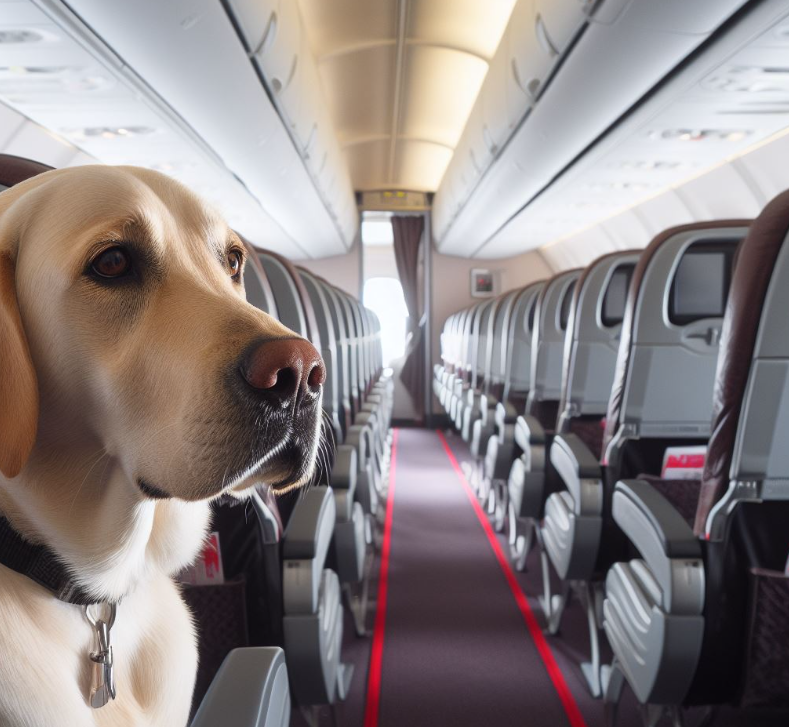
Service Dogs vs. Emotional Support Animals - there seems to be a never-ending dispute in regard to the status of these animals, what they do, and what rights they are entitled to.
We all know that although Emotional Support Animals provide comfort and companionship, or just “emotional support” as the name implies, their presence has proved extremely helpful to many individuals dealing with mental and emotional illnesses. ESAs have also been a great support to people who due to a physical disability have their mental health worsened.
Despite the unquestionable benefits of ESAs for many individuals with disabilities, they have limited access to public places and to the passenger cabins of the aircraft of most airlines.
Today’s article may give hope to many individuals who rely on their ESAs for assistance, and who want to have a stress-free experience when flying with them!
Why Do ESAs Have Limited Access Rights Compared to Service Dogs?
While service dogs undergo specialized training, that encompasses basic obedience, specific service dog tasks, directly related to a person’s disability, and public manners, requirements toward ESAs are not so strict! Unlike service dogs, ESAs need to be well-mannered, but specific tasks are not required of them.
“Specialized training” is exactly the aspect that makes the biggest difference between both types of animals. It serves as the reason for providing service animals with the status of “medical equipment”, and not pets.
The access rights of service dogs extend beyond visiting public places that are open to use by the public and also encompass flying in the passenger cabin for free. This is a privilege that ESAs no longer have.
A further requirement for service animals, along with the specific training, is the animal species. In contrast to ESAs, who can be any type of domesticated species, service animals can be dogs only (or miniature horses in several US states).

How Did the Revision of the Air Carrier Access Act (ACAA) Affect the Service Dog Policies of Major Airlines?
On December 02nd, 2020, the U.S. Department of Transportation announced that it is revising its Air Carrier Access Act (ACAA) regulation in regard to the transportation of service animals by air. The main goal of this revision was to ensure a safe and accessible air transportation system.
After more than 15,000 people had given their feedback in regard to this matter, a final rule in regard to flying with service animals was announced. It addressed the concerns of individuals with physical and/or mental impairments, flight attendants, airlines, airports, and members of society.
We will list three of the new regulations that came into effect after the revision:
- Defines a service animal as a dog that is individually trained to do work or perform tasks for the benefit of a person with a disability;
- No longer considers an emotional support animal to be a service animal;
- Requires airlines to treat psychiatric service animals the same as other service animals.
A complete list of the new rules can be found on the website of the U.S. Department of Transportation.
Mainly individuals benefiting from the assistance of Emotional Support Animals were affected by the changes.
Most major airlines, both the US and non-US ones, complied with the new regulations of the U.S. Department of Transportation and stopped accepting ESAs in the passenger cabin.
Since we will be discussing the new regulations for flying with an ESA in Canada, we will list below a portion of the new service dog policy of Air Canada as an example of how it was affected by the revision of the ACAA.
“Please note we have adopted a new policy on the transport of service dogs, following substantial changes to the U.S. Department of Transportation’s (DOT) rules on the topic. Effective March 1, 2021, emotional support animals are no longer accepted in the cabin”.
As a natural consequence of these changes, many individuals whose emotional and mental health have benefited from the use of an ESA, were negatively affected.

Traveling with Emotional Support Animals in Canada- New Rules
On June 23rd, the Canadian Transportation Agency (Agency) issued a final decision no. 105-at-c-a-2023 in regard to traveling with Emotional Support Animals (ESAs).
According to the new rule:
-
Carriers must allow only dogs as Emotional Support Animals;
-
Individuals with disabilities must provide a medical letter, issued by a physician or medical health professional as proof that they are being treated for a mental health illness and require an ESA to assist them due to that disability;
-
Individuals traveling with ESDs must submit, at least 96 hours in advance of travel, a veterinary certificate that identifies the individual with a disability and their dog, and that confirms the dog’s current vaccination and health status. If there are no specific timing requirements for veterinary certification in the country, province, state, or territory the person is traveling to or from, the certificate should be issued no earlier than two months before the initially scheduled travel date mentioned in the itinerary;
-
The Emotional Support Dogs must fit comfortably in an appropriate carrier that must fit and be kept at the seat, or in the case of air travel, under the seat, in front of the individual with a disability, throughout the trip. The animal carrier must meet the carrier’s requirements and restrictions for animal carriers in the cabin; the ESD must remain in the carrier for the duration of the trip in the passenger cabin;
-
The individuals traveling with ESDs must verify that their ESDs meet all travel, entry, or exit requirements of the country, province, state, or territory they travel to or from. This includes providing all required documentation, as applicable.
Individuals
with a disability who travel with their Emotional Support Dogs and
who comply with the conditions listed above must not be charged for
this accommodation.
When Are Carriers Allowed to Refuse an ESA Accommodation?
Carriers are allowed to refuse to accommodate an individual with a disability and their ESD, if:
- The dog poses a threat to the health and safety of others by behaving aggressively or otherwise inappropriately;
- The individual is unable to control the dog;
- The individual removes the dog from the carrier during travel.
“The Agency determined that requiring carriers to accept species of ESAs other than dogs would cause them undue hardship as would the unrestricted carriage of Emotional Support Dogs (ESDs) due to health and safety risks, animal behavior and welfare concerns, and the impacts of fraudulent representation of pets as ESDs.”
It is important to note that the new regulation does not affect the requirements for traveling with service dogs and their acceptance by airlines. Service dogs are dogs who have been individually trained to do specific work/tasks for an individual with a disability, directly related to that disability. Unlike service dogs, Emotional Support Animals do not undergo specific training and do not perform a specific task, that is directly related to a disability. Their role is to provide comfort and companionship to individuals with mental illnesses.
If you are interested in receiving more detailed background information on the new regulations, you can click the following page: Background on the decision related to traveling with emotional support animals.












